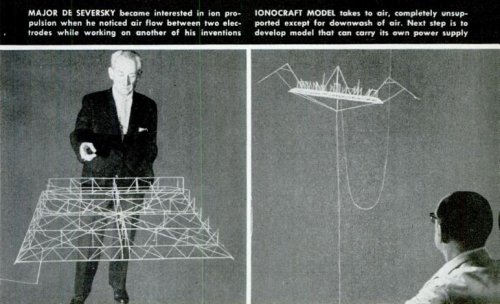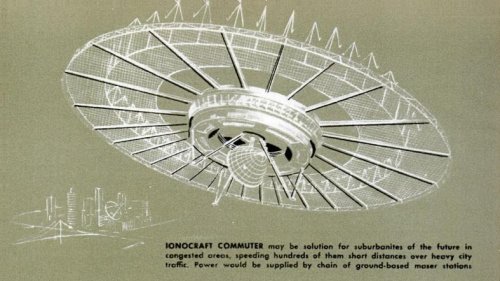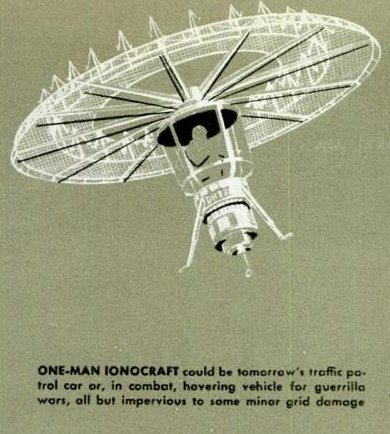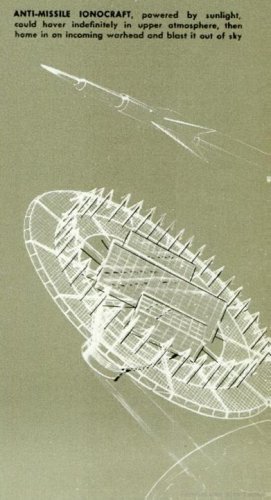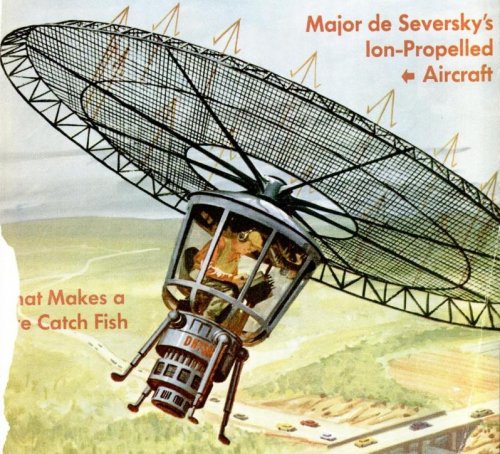The magic carpet, called the Ionocraft, flies on pure electricity. It depends specifically on the fundamental principle of electricity that electric current always flows from negative to positive, and it uses two basic pieces of equipment to take advantage of this principle --- tall metal spikes that are installed above an open wire-mesh grid.
High negative voltage is shot from the spikes toward the positively charged wire grid, just like negative and positive poles on an ordinary battery. As the negative charge leaves the spike arms, it peppers the surrounding air like buckshot, putting a negative charge on some of the air particles. Such negatively charged air particles are called ions, and these are attracted downward by the positively charged grid.
In their mad rush from the ion emitter to the main grid, the ions bump into neutral air molecules-air particles without electric charge. The terrific wallop in these collisions hurls a mass of neutral air down-ward along with ions. When they reach that air grid, the ions being negative are trapped by positive charge on the grid. but the grid has no attraction for the neutral air particles that got bumped along. So the air flows right through the open grid mesh, making a downdraft beneath the Ionocraft. The contraption rides on this shaft of air, getting lift just like a helicopter --- by sucking air down from the top.
"Aerodynamically, it works just like a chopper (...) But instead of using a rotor and blades, we create the downward air flow electrically by means of ionic discharge. The ions act on the air like a man treading water. They just push down."
The engineers working on Ionocraft are the first to admit that their present rig is still a long way from any kind of practical aircraft. The model we saw measures only 1296 square inches and consists of about $5 worth of balsa wood and aluminum wire. But the principle holds an important promise for the future of aviation.
The problem now is improving efficiency --- getting enough lift from a given grid area and a given amount of energy, Present models cannot yet lift their own electric generators. they get power through a feeder cable, dangling down like an umbilical cord. Ionocraft engineers tend to be close-mouthed on performance figures.
But they will tell you that at present it takes 90 watts (30,000 volts at 3 milliamperes) to fly a two ounce model. Translated into ordinary power-to-weight ratios, this works out to roughly 0.96 hp. per pound, as compared with a typical 0.1 hp per pound of helicopter or 0.065 hp for a pound Piper Cub.
But Ionocraft designers are hard at work upping efficiency. One possible power --- boosting technique is to pulse the power in short high energy bursts rather than apply steady voltage. They are also trying out various grid patterns and ion emitter layouts to minimize energy loss through turbulence in the downdraft.
Despite such unresolved problems, the development crew almost bristles with optimism, and the most optimistic of all is the Ionocraft's inventor Major Alexander P. de Seversky. No crackpot, Major de Seversky is a practical visionary who in many areas has been far in front of his field.
"We hope to fly a model with self-contained power, perhaps by the end of the year (...) Ultimately, the ionic drive will prove more efficient than either propeller or jet as a method of aircraft propulsion."


